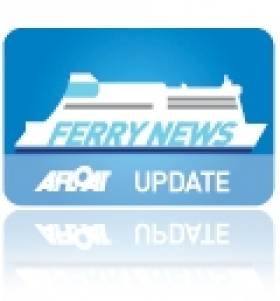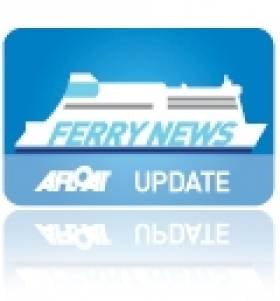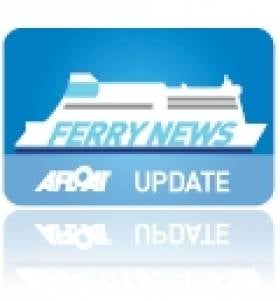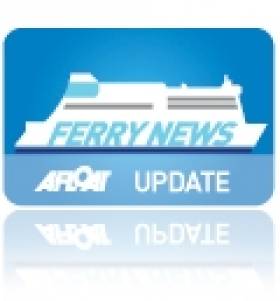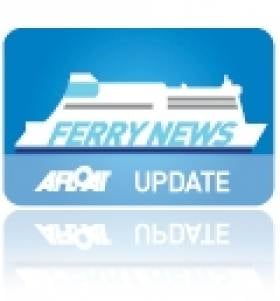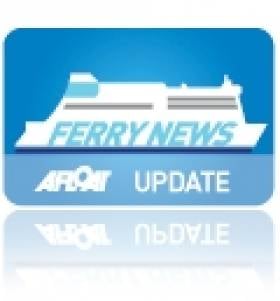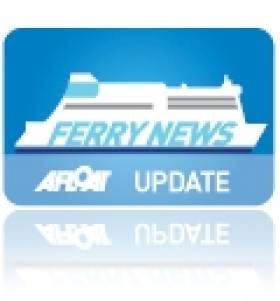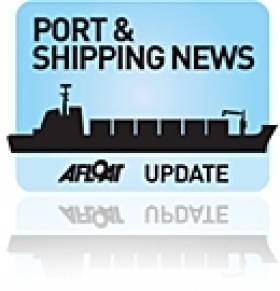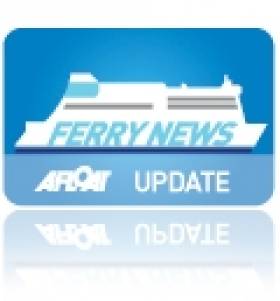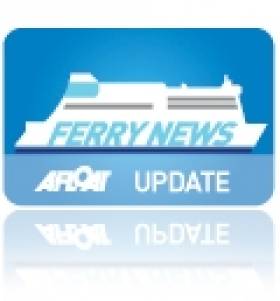Displaying items by tag: Stena Line
#FarewellHSS- A fast-ferry that served the Belfast-Stranraer route, which no longer exists, departed Belfast for the final time at the weekend. The ferry HSS Stena Voyager is bound for Sweden where she is to be scrapped, writes Jehan Ashmore.
The 19,000 tonnes Stena Voyager is under tow to the Öresundsvarvet shipyard in Landskrona, where she will be recycled by a subsidiary of the ferry company, Stena Recycling.
All of the vessels various components will be recycled, as far as is possible, to maintain the company's environmental reputation. Some of the materials will even be reused in the form of car parts or furniture.
Stena Voyager was displaced on the Northern Channel route in November 2011 following the change of Scottish port, from Stranraer at the end of the lough to Cairnryan which is closer to the open sea.
In addition a pair of conventional yet fast ro-pax 'Superfast' ferries were introduced bringing superior facilities coupled with greater freight capacity.
These factors combined with a shorter passage time between Belfast and Cairnryan and rising fuel costs over several years saw the writing on the wall for the HSS craft, which when introduced in the mid 1990's were the pride of the Stena Line fleet.
The Swedish ferry giant commissioned a trio of HSS (High Speed sea-Service) fast-craft, whose futuristic appearance and technology was adopted from the world of aviation that included gas-turbine engines to power water-jets producing up to 40 knots.
Stena Voyager carried 1,500 passengers and 375 cars and she was launched onto the North Channel route in 1996, since then the fast-craft has carried more than 17m passengers and over 45,000 sailings.
"Whilst the HSS class was a unique and highly innovative development for Stena Line, unfortunately the spiralling costs of operating the Stena Voyager have become all too high. When the Voyager was first put into service fuel was approximately $20 per barrel and now the price is around $110 dollar, for a fuel hungry vessel this is simply untenable," said Michael McGrath, Stena Line's Chief Operating Officer.
The first of the revolutionary craft was HSS Stena Explorer which currently maintains the seasonal-only Dun Laoghaire-Holyhead having been also introduced in 1996. Final member of the class was HSS Stena Discovery which served Harwich-Hook van Holland from 1997, however she was the first to go and now serves operators out of Venezuela.
The concept of the HSS craft were also to compete with air-travel on the short hop between Northern Ireland and Scotland. In tandem the HSS ran alongside older conventional ferries, among them Stena Caledonia, which was sold last year to Indonesian operator ASDP and renamed Port Link.
Stena Line HSS Fast-Craft Sailings Cancelled
#SailingsCancelled – According to the Stena Line website, today's (Friday 22 March) HSS Stena Explorer fast-craft sailing departing at 13.30HRS from Dun Laoghaire to Holyhead has been cancelled.
All passengers en route to the port are advised to contact the Stena Line (24hrs) ferrycheck number (01) 204 7799 for the most up-to-date information about the sailings.
In addition to consulting information from this LINK.
Ferries Get Red Noses & Turn All Green!... for Weekend Events
#FerryColourful – This weekend saw a Stena Line ferry or two getting big Red Noses and turning Green –well almost!...to mark the UK's Red Nose Day and Ireland's St. Patrick's Day.
Red Nose Day which celebrated its 25th anniversary this year was held last Friday and despite the economic climate, the charity fundraiser appeal raised a staggering £75m.
On board Stena ferries a host of fundraising activities took place including a range of specially created red nose muffins, sales of which along with other activities will go to Comic Relief.
Around the World the iconic images including the Pyramids of Giza and Leaning Tower of Pisa are to turn green this weekend for St Patrick's Day festivities.
Closer to home, Stena Line didn't want to turn green with envy so they turned out one of their Belfast-Birkenhead ferries to a shade of green instead... albeit with some imagination!
Stena HSS Is Back for Easter and Summer Service
#HSSisBack–The HSS Stena Explorer fastcraft is back on the Dun Laoghaire-Holyhead route and Stena Line have a 'super spring sale' giving customers the opportunity to save up to 20% off its lowest fares.
The offer is available for travel up until 30 June from Dublin-Holyhead, Rosslare-Fishguard and on the Dun Laoghaire-Holyhead seasonal-only service.
Diane Poole Head of Stena PR and Communications said: "With Easter just around the corner and school holidays, we're offering customers the chance to enjoy a short break without breaking the bank".
The sale which starts with a lowest fare of €89* single (see web for T&A) for car and driver is now available every day of the week allowing people to save up to 20% on travel when they book by 28 February.
The HSS will operate one departure from Dun Laoghaire and Holyhead daily during this season, for information on the Spring sale and more visit: www.stenaline.ie/sale
Stena Send in ‘Freight-Only’ Ferry to Replace Damaged Chartered Ferry
#FerryBackUp – Freight ferry Stena Scotia (1996/13,017grt) docked in Dublin Port yesterday for 'berthing trials' and is to provide extra capacity for freight customers next week, writes Jehan Ashmore.
She is a replacement to the damaged chartered ferry Finnarrow, which as previously reported has since reached Scotland, with a tug berthing in Greenock.
The Dutch flagged Stena Scotia (capacity: 114 trailer units) will start freight-sailings next Monday (25 February) to Holyhead, where the 12-driver-accompanied vessel had called en-route yesterday also for berthing trials, having made an overnight passage from Belfast.
It was at the Anglesey port last weekend, where an incident involved the Finnarrow's stabilisers that led to cancelled sailings.
Stena Scotia will run in tandem with ro-pax Stena Adventurer (which takes passengers) on the Dublin route. There will also be additional passenger back-up with fastcraft HSS Stena Explorer sailings on the Dun Laoghaire-Holyhead route.
All passengers are advised to call Stena Line ferrycheck number 08705 755 755, for the most up-to-date information on sailings for 'foot' and those that are 'vehicle-only' by clicking this LINK.
The other regular Dublin route serving ro-pax Stena Nordica is as previously reported on refit cover on the North Channel and is expected to return to service on 19 March.
Stena Scotia (and sister 'Hibernia') had been lying idle in Belfast since September, having been replaced by larger chartered tonnage in the form of newbuild sisters, Stena Performance and Stena Precision.
The pair (from a quartet of newbuilds built last year) operate Stena's Belfast-Heysham freight service, following a short career starting off on the Irish Sea for operators Seatruck.
She has seen a succession of name changes in recent years, as Scotia Seaways under the navy blue colours of DFDS Seaways during a brief entry into the Irish Sea market in 2010.
Before that, she sported the pale blue livery scheme under Maersk / Norfolkline North Sea service as the Maersk Exporter completed in 1996.
Chartered Finnish Ferry Heads for Scotland following Incident
#FinnishFerry –Following an inspection of Finnarrow due to a 'stabiliser incident' in Holyhead at the weekend, the chartered Finnish ferry requires further attention. The 25,996 tonnes vessel, having departed Anglesey today with a tug bound for Scotland, writes Jehan Ashmore.
As previously reported on Afloat.ie, Stena Line yesterday reactivated the fastcraft HSS Stena Explorer, with an earlier than planned opening of the Dun Laoghaire-Holyhead, a seasonal-only operated service which otherwise would not resume until late March.
In the meantime Stena Explorer is providing back-up operations for passengers, in the absence of Finnarrow sailings on the Dublin Port-Holyhead route. A second route ferry, Stena Adventurer, is as usual maintaining sailings on the Dublin Port-Holyhead route.
Passengers due to travel with Stena Line should note the 'latest' information on sailing times. In addition passengers should take particular note of certain sailings for 'foot' passengers and 'vehicle-only' sailings. For information visit: www.stenaline.ie/ferry/latest-sailing-information/
The 'Adventurer's fleetmate Stena Nordica firstly headed for the St. Georges Channel route, having been replaced on the Dublin route by the chartered Finnarrow in late January.
Stena Nordica is currently running Belfast-Cairnryan sailings, while the 'Superfast' sisters each take turns for annual maintenance at Harland & Wolff, Belfast.
Stena Line to Reactivate HSS Service Following Ferry Incident
#FerryDisruption - According to ITV Wales, there was an incident on board the Finnarrow, a ferry on charter to Stena Line, while berthing in Holyhead at the weekend.
Stena Line has confirmed the incident at the Welsh port on Saturday, occured as the ferry was berthing after a sailing from Dublin Port, which involved the ships stabilisers. All 77 passengers and 43 crew were evacuated and the vessel was safely berthed.
The vessel is currently docked in Holyhead undergoing inspections and will remain out of service for the immediate future. Since then sailings by the Finnarrow have been cancelled.
Passengers due to travel on Stena Line's Holyhead-Dublin Port route also operated by the Stena Adventurer, will be accommodated on alternative sailings.
Afloat.ie adds that the HSS fastcraft Stena Explorer is to make an earlier than expected return to the Dun Laoghaire-Holyhead route tomorrow (19 February) so to cover the chartered Finnarrow's sailings, until further notice.
The HSS fastcraft will operate a daily single round-trip service, departing Holyhead at 10.30hrs and from Dun Laoghaire departing at 15.05hrs.
Ports & Shipping Review- Research Vessel Returns, Record Cruise Season, Fast & Slow Ferry Refits, Port Upgrade and Riverferry's Fate?
#ShippingREVIEW- Over the last fortnight, Jehan Ashmore has reported from the shipping scene, where the Geological Survey of Ireland (GSI) research vessel Keary, returned to Dun Laoghaire Harbour following modification work at Arklow Marine Services.
A record total of 64 cruiseships are to call to Cork Harbour, making the 2013 season the busiest year to date and includes six maiden calls and two cruiseships will make overnight calls.
The New Year brought changes at Ardmore Shipping, where new promotions have been made for personnel at senior management level.
Not a single fast ferry is to be found operating on the Irish Sea, not to bad weather, but for the brief absence of Irish Ferries Jonathan Swift, currently in refit, from year-round Dublin-Holyhead service.
One of Stena Line's Dublin Port-Holyhead route ships, Stena Nordica is on relief duty, covering for Stena Europe between Rosslare-Fishguard. In place of the 'Nordica' Dublin sailings, the chartered Finnarrow is maintaining sailings to Holyhead.
A major upgrade of the Scottish ferryport of Cairnryan, on Loch Ryan, has begun to improve operations for P&O Ferries short-sea route to Larne.
According to the Port of Cork, a total of 9.05 million tonnes in trade traffic levels was reached at the end of 2012, not since 2008, has the port surpassed 9m tonnes.
Royal Daffodil, one of the famous Mersey Ferries fleet due to be withdrawn, has been discussed with the National Waterways Museum, but no decision has been made as of yet.
The efforts of Cruise Belfast has paid off as the 2013 cruise season is to be a record year with close to 60 calls bringing more than 100,000 visitors to Belfast Harbour.
Ferry Fare Offers for Rugby Fans
#RugbyFerry – Special sporting offers from Stena Line are available for those heading off to the RBS Rugby Six Nations Ireland v Wales game in the Millennium Stadium, Cardiff on 2 February.
For motorists, there is a lead-in fare from €89 single car plus driver on Stena Line Irish Sea routes, with exception of Dun Laoghaire-Holyhead route, which resumes in late March. The fare on this seasonal-only operated route is from €139 single car plus driver.
If travelling as a 'foot' passenger, the fare is from €35 single per adult and applies to Dublin Port-Holyhead and Rosslare-Fishguard routes.
For those taking the Sail N' Rail combination, the fare starts from €39 single per adult, when booked in advance on the Rosslare-Fishguard route and onwards to Cardiff.
For further information including inclusive ferry and hotel-break offer visit: www.stenaline.ie/ferry/wales-ireland or call 01 204 7777
#FerryREFITS – Stena Line's charter of Finnarrow, which as previously reported on Afloat.ie, entered service on the Dublin Port-Holyhead route allowed Stena Nordica to relief the Rosslare-Fishguard ferry, and not as previously indicated go straight to annual refit.
Instead Stena Nordica, has replaced the St. Georges Channel route ferry Stena Europe, which sailed northbound to dry-dock at Harland & Wolff, Belfast. She is sharing the dry-dock with P&O's fast-craft Express, which too is undergoing annual maintenance having shifted berths from Donegall Quay.
The Stena Nordica of 24,206grt, is no stranger to Rosslare, having made an en-route call on certain weekend's while running P&O's Dublin Port-Cherbourg route as the European Ambassador, until the route closed in 2004.


























